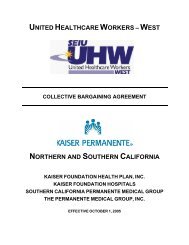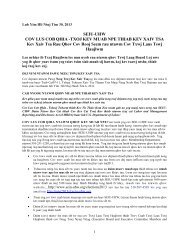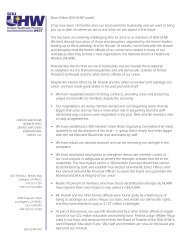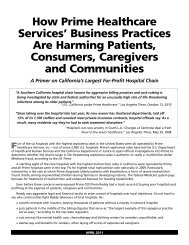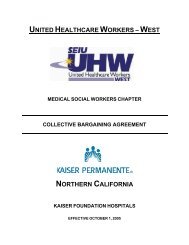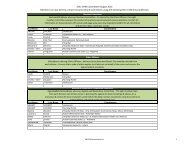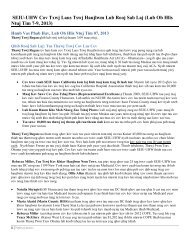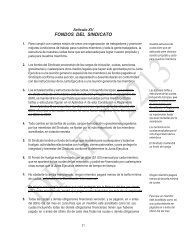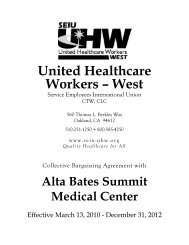Care and Coding at Prime Healthcare Services - SEIU-UHW ...
Care and Coding at Prime Healthcare Services - SEIU-UHW ...
Care and Coding at Prime Healthcare Services - SEIU-UHW ...
You also want an ePaper? Increase the reach of your titles
YUMPU automatically turns print PDFs into web optimized ePapers that Google loves.
B - 126<br />
Purple-WEB<br />
#4A2C7D<br />
B - 0<br />
Yellow-WEB<br />
#FFDE00<br />
<strong>Care</strong> <strong>and</strong> <strong>Coding</strong> <strong>at</strong><br />
<strong>Prime</strong> <strong>Healthcare</strong><br />
<strong>Services</strong><br />
70% 25%<br />
Analysis by <strong>SEIU</strong>-<strong>UHW</strong><br />
January 2011<br />
Full Color Spectrum<br />
Purple Background<br />
Purple-CMYK<br />
C - 88<br />
M - 100<br />
Yellow-CMYK<br />
C - 2<br />
M - 9
<strong>SEIU</strong>-<strong>UHW</strong>’s October, 2010 analysis of newly-available 2009 Medicare bills filed by <strong>Prime</strong> <strong>Healthcare</strong><br />
demonstr<strong>at</strong>es th<strong>at</strong> <strong>Prime</strong> billed the public for serious medical conditions <strong>at</strong> startling r<strong>at</strong>es. These findings<br />
come on the heels of uniquely high r<strong>at</strong>es of septicemia billed by <strong>Prime</strong> to the public in 2008. In addition to<br />
septicemia, the report highlights extreme r<strong>at</strong>es of malnutrition billed by <strong>Prime</strong> hospitals.<br />
<strong>Coding</strong> <strong>and</strong> <strong>Care</strong> <strong>at</strong> <strong>Prime</strong>: 2009<br />
As in 2008, in 2009, <strong>Prime</strong> <strong>Healthcare</strong>’s hospitals had the highest septicemia r<strong>at</strong>es in the United St<strong>at</strong>es.<br />
At the same time, the r<strong>at</strong>es of other serious complic<strong>at</strong>ions have soared <strong>at</strong> <strong>Prime</strong> hospitals, <strong>and</strong> this report<br />
highlights the extraordinary r<strong>at</strong>es of malnutrition reported by <strong>Prime</strong> in its Medicare bills.<br />
<strong>Prime</strong> <strong>Healthcare</strong>, a system th<strong>at</strong> tre<strong>at</strong>ed less than 4% of all California’s Medicare inp<strong>at</strong>ients in 2009, billed<br />
Medicare for 28% of the severely malnourished p<strong>at</strong>ients in the st<strong>at</strong>e.<br />
This report highlights our key findings, explains how high septicemia <strong>and</strong> complic<strong>at</strong>ion r<strong>at</strong>es <strong>at</strong> <strong>Prime</strong>oper<strong>at</strong>ed<br />
hospitals lead to heightened Medicare reimbursement for <strong>Prime</strong>, <strong>and</strong> estim<strong>at</strong>es potential<br />
Medicare overpayments <strong>at</strong> $28 million for the year, bringing the two-year total to $46 million.<br />
Contents<br />
• <strong>SEIU</strong>-<strong>UHW</strong><br />
• Septicemia R<strong>at</strong>es, 2009 Upd<strong>at</strong>e<br />
• Medicare Reimbursement, 2009 Upd<strong>at</strong>e<br />
• Dubious Distinction, 2009 Upd<strong>at</strong>e<br />
• Major Complic<strong>at</strong>ions <strong>and</strong> Comorbidities <strong>at</strong> <strong>Prime</strong>, Background<br />
• Malnutrition <strong>at</strong> <strong>Prime</strong> Hospitals, 2009<br />
• Recap<br />
• Conclusion<br />
1
<strong>SEIU</strong>-<strong>UHW</strong><br />
<strong>SEIU</strong> United <strong>Healthcare</strong> Workers-West (<strong>SEIU</strong>-<strong>UHW</strong>) is the largest healthcare union in the western U.S. with<br />
more than 150,000 members. <strong>SEIU</strong>-<strong>UHW</strong> is part of the 2.2 million-member Service Employees Intern<strong>at</strong>ional<br />
Union (<strong>SEIU</strong>).<br />
The opening pledge in the <strong>SEIU</strong> Mission St<strong>at</strong>ement of the <strong>SEIU</strong> Constitution <strong>and</strong> Bylaws st<strong>at</strong>es a broad<br />
vision <strong>and</strong> goal for our Union:<br />
“We are the Service Employees Intern<strong>at</strong>ional Union, an organiz<strong>at</strong>ion of more<br />
than 1 million members united by the belief in the dignity <strong>and</strong> worth of<br />
workers <strong>and</strong> the services they provide <strong>and</strong> dedic<strong>at</strong>ed to improving the lives of<br />
workers <strong>and</strong> their families <strong>and</strong> cre<strong>at</strong>ing a more just <strong>and</strong> humane society.”<br />
<strong>SEIU</strong> is engaged in a labor dispute with <strong>Prime</strong>. Not surprisingly, we often find th<strong>at</strong> the same corpor<strong>at</strong>e<br />
employers who fail to tre<strong>at</strong> their employees with dignity, respect <strong>and</strong> fairness are also failing to be<br />
responsible corpor<strong>at</strong>e citizens in other areas. As one of the largest progressive advocacy groups in North<br />
America, <strong>SEIU</strong> believes it is important to call <strong>at</strong>tention to these other areas where corpor<strong>at</strong>ions have been<br />
poor corpor<strong>at</strong>e citizens – such as the environment, industry regul<strong>at</strong>ion, shareholder accountability, p<strong>at</strong>ient<br />
care st<strong>and</strong>ards, tax compliance, global st<strong>and</strong>ards, anti-corruption <strong>and</strong> anti-fraud issues – for two reasons.<br />
First, workers <strong>and</strong> their communities often suffer as a consequence of irresponsible <strong>and</strong> unethical<br />
corpor<strong>at</strong>e behavior in these areas. Second, poor tre<strong>at</strong>ment of workers is generally a symptom of a larger<br />
problem of a misguided corpor<strong>at</strong>e culture. It is extremely difficult to change irresponsible labor policies in<br />
isol<strong>at</strong>ion from a larger reform of corpor<strong>at</strong>e practices. Building alliances with other reform-minded groups<br />
on a domestic <strong>and</strong> global scale promotes the ability to achieve reform of corpor<strong>at</strong>e labor policies.<br />
In conducting a corpor<strong>at</strong>e accountability campaign, we work alone <strong>and</strong> with community allies <strong>and</strong><br />
governmental agencies to responsibly investig<strong>at</strong>e <strong>and</strong> expose to public view inappropri<strong>at</strong>e corpor<strong>at</strong>e<br />
conduct of wh<strong>at</strong>ever type <strong>and</strong> thus positively impact a broad range of CSR issues 1 . As a union with<br />
resources <strong>and</strong> commitment to building a more just <strong>and</strong> humane society, we believe our CSR campaigns<br />
carry out an important role by influencing companies to become more responsible corpor<strong>at</strong>e citizens.<br />
When th<strong>at</strong> happens, workers are empowered to play a vital role in not only improving their own working<br />
conditions, but also addressing broader community concerns.<br />
2<br />
1<br />
“The term ‘corpor<strong>at</strong>e social responsibility’ or CSR has been coined to define how companies behave<br />
in social, environmental <strong>and</strong> ethical contexts. Corpor<strong>at</strong>e social responsibility is about integr<strong>at</strong>ing the<br />
issues of the workplace, the community <strong>and</strong> the marketplace into core business str<strong>at</strong>egies. Driving<br />
this emerging field are customers who choose products with a good reput<strong>at</strong>ion, investors who put<br />
money into a company with an exemplary record <strong>and</strong> firms which invest in the future or training<br />
of their employees <strong>and</strong> gain loyalty <strong>and</strong> commitment in return.” (from the Yale University School of<br />
Management website, 2006)
<strong>SEIU</strong>-<strong>UHW</strong> represents hundreds of caregivers <strong>at</strong> four of <strong>Prime</strong>’s 14 hospitals. <strong>Prime</strong>’s anti-worker <strong>and</strong> antilabor<br />
policies have produced a terrible record of callous tre<strong>at</strong>ment of workers’ rights <strong>and</strong> community<br />
needs. Labor disputes have arisen <strong>at</strong> <strong>Prime</strong> facilities <strong>at</strong> Garden Grove, Shasta Regional, <strong>and</strong> Centinela<br />
Medical Center, among others. The Union has proceeded to interest arbitr<strong>at</strong>ion, to district court, <strong>and</strong> to<br />
bankruptcy court b<strong>at</strong>tling <strong>Prime</strong> <strong>and</strong> its tactics. The Union has also filed numerous Unfair Labor Practice<br />
charges with the N<strong>at</strong>ional Labor Rel<strong>at</strong>ions Board regarding <strong>Prime</strong>’s activities. At <strong>Prime</strong> hospitals, the<br />
company has cut the workforce, reduced wages <strong>and</strong> benefits, <strong>and</strong> <strong>at</strong>tacked worker protections th<strong>at</strong> were<br />
once guaranteed by collective bargaining agreements.<br />
In this report, as always, <strong>SEIU</strong>-<strong>UHW</strong> st<strong>and</strong>s up for fair tre<strong>at</strong>ment of California hospital workers, <strong>and</strong> integrity<br />
in dealing with p<strong>at</strong>ients, caregivers <strong>and</strong> the public.<br />
Septicemia R<strong>at</strong>es, 2009 Upd<strong>at</strong>e<br />
These findings are presented as an upd<strong>at</strong>e to the 2008 d<strong>at</strong>a, <strong>and</strong> follow the same methodology discussed<br />
in our recent report, “Septicemia <strong>at</strong> <strong>Prime</strong> Hospitals”. Key findings are comparable:<br />
Federal Fiscal Year 2008 Federal Fiscal Year 2009<br />
q 7 of the 12 hospitals with the highest<br />
q 5 of 6 hospitals with the highest<br />
septicemia r<strong>at</strong>es in the U.S. oper<strong>at</strong>ed by<br />
septicemia r<strong>at</strong>es in the U.S. were<br />
<strong>Prime</strong><br />
oper<strong>at</strong>ed by <strong>Prime</strong><br />
q 11 of 12 <strong>Prime</strong> hospitals with the<br />
highest septicemia r<strong>at</strong>es were in the<br />
top 5%, n<strong>at</strong>ionally<br />
q <strong>Prime</strong>’s septicemia r<strong>at</strong>e was 70%<br />
higher than the second-highest<br />
comparable health system<br />
q 11 of 13 <strong>Prime</strong> hospitals with the highest<br />
septicemia r<strong>at</strong>es were in the top 5%,<br />
n<strong>at</strong>ionally<br />
q <strong>Prime</strong>’s septicemia r<strong>at</strong>e was 50% higher<br />
than the second-highest comparable<br />
health system, <strong>and</strong> 5 st<strong>and</strong>ard devi<strong>at</strong>ions<br />
above the mean<br />
3
<strong>Prime</strong>’s Shasta Regional Medical Center (SRMC), acquired by <strong>Prime</strong> around November 1, 2008, provides a<br />
remarkable before-<strong>and</strong>-after picture: the septicemia r<strong>at</strong>e doubled when <strong>Prime</strong> took over.<br />
4
Septicemia r<strong>at</strong>es <strong>at</strong> all 13 <strong>Prime</strong> hospitals in 2009, listed below, indic<strong>at</strong>e th<strong>at</strong> septicemia r<strong>at</strong>es remain <strong>at</strong><br />
extremely high levels. Only one <strong>Prime</strong> hospital, Centinela, falls below the 90th percentile; following <strong>Prime</strong>’s<br />
takeover, Shasta leapt into the top 4%.<br />
5
Medicare Reimbursement, 2009 Upd<strong>at</strong>e<br />
In our analysis of 2008 billing d<strong>at</strong>a, <strong>SEIU</strong>-<strong>UHW</strong> estim<strong>at</strong>ed potential excess Medicare reimbursement to<br />
<strong>Prime</strong> <strong>at</strong> $18 million. Using the same methodology, the potential excess reimbursement in 2009 was over<br />
$28 million, bringing the two-year total to $46 million.<br />
As discussed below, startling r<strong>at</strong>es of serious medical complic<strong>at</strong>ions in addition to septicemia - including<br />
severe malnutrition - contribute to the high severity levels billed by <strong>Prime</strong>. The average severity level<br />
among Medicare p<strong>at</strong>ients tre<strong>at</strong>ed <strong>at</strong> <strong>Prime</strong> was 4 st<strong>and</strong>ard devi<strong>at</strong>ions above the mean. The second-highest<br />
severity level among all comparable U.S. health systems was just over 2 st<strong>and</strong>ard devi<strong>at</strong>ions above the<br />
mean. In other words, for general medical care, <strong>Prime</strong> was the best-paid hospital system in the United<br />
St<strong>at</strong>es by an extraordinary margin. These results are shown graphically in the figure below.<br />
6
As in the 2008 analysis, to obtain an apples-to-apples comparison we removed centers of care th<strong>at</strong> are<br />
not comparable between hospitals; the result includes Medicare p<strong>at</strong>ients 65 <strong>and</strong> older admitted to a<br />
short term acute care hospital <strong>and</strong> tre<strong>at</strong>ed for a medical (i.e., non-surgical) DRG in a non-specialty Major<br />
Diagnostic C<strong>at</strong>egory (e.g.: HIV, cancer, burns, major trauma). By “comparable” health system, we mean<br />
all 94 health systems th<strong>at</strong> had <strong>at</strong> least 10,000 qualifying fee-for-service Medicare stays in federal fiscal year<br />
2009. <strong>Prime</strong> had 18,576 qualifying stays.<br />
7
Dubious Distinction, 2009 Upd<strong>at</strong>e<br />
How extreme r<strong>at</strong>es lead to false quality scores<br />
<strong>Prime</strong> has won numerous awards for its quality of care, awards it recently touted when confronted with<br />
the high r<strong>at</strong>es of septicemia reported by <strong>SEIU</strong>-<strong>UHW</strong>. See, for example, the health system’s October 12,<br />
2010, press release, “<strong>Prime</strong> <strong>Healthcare</strong> Responds to Union’s (<strong>SEIU</strong>) Smear Campaign”. 2 The first <strong>Prime</strong><br />
response is:<br />
By all objective measures, <strong>Prime</strong> <strong>Healthcare</strong> hospitals provide excellent p<strong>at</strong>ient care. <strong>Prime</strong> <strong>Healthcare</strong> was the only<br />
for-profit health system to be recognized as a Top 10 Health System in the N<strong>at</strong>ion by Thomson Reuters <strong>and</strong> several of<br />
its hospitals, including Desert Valley Hospital, West Anaheim Medical Center, <strong>and</strong> Montclair Hospital Medical Center,<br />
have been ranked among the Top 100 Hospitals in the N<strong>at</strong>ion by Thomson Reuters. Thomson Reuters has concluded<br />
th<strong>at</strong> if all Medicare beneficiaries received care like they do <strong>at</strong> Thomson Reuters’ Top 10 Health Systems <strong>and</strong> Top 100<br />
Hospitals (like <strong>Prime</strong> <strong>Healthcare</strong> hospitals), more than 47,000 p<strong>at</strong>ients would survive each year <strong>and</strong> nearly 92,000 p<strong>at</strong>ient<br />
complic<strong>at</strong>ions would be avoided annually. At the same time, Chino Valley Medical Center, Centinela Hospital Medical<br />
Center, Desert Valley Hospital, <strong>and</strong> Garden Grove Hospital & Medical Center received HealthGrades 2010 Emergency<br />
Medicine Excellence Award which places these hospitals among the Top 5% of all hospitals for outst<strong>and</strong>ing emergency<br />
medicine services, <strong>and</strong> 10 of <strong>Prime</strong> <strong>Healthcare</strong>’s hospitals received 5 out of 5 stars in HealthGrades 2010 Quality Report<br />
for Sepsis.<br />
Our previous report, “Septicemia <strong>at</strong> <strong>Prime</strong> Hospitals,” discusses how inaccur<strong>at</strong>e reporting of high p<strong>at</strong>ient<br />
acuity leads to infl<strong>at</strong>ed quality scores. The easy explan<strong>at</strong>ion is simply th<strong>at</strong> you don’t die if you<br />
aren’t really sick.<br />
For example, if a hospital system<strong>at</strong>ically reports th<strong>at</strong> p<strong>at</strong>ients have life-thre<strong>at</strong>ening septicemia, but the<br />
p<strong>at</strong>ients actually have urinary tract infections or other rel<strong>at</strong>ively minor conditions, two things happen: (1)<br />
the p<strong>at</strong>ients have a remarkably good survival r<strong>at</strong>e; <strong>and</strong> (2) many p<strong>at</strong>ients get out of the hospital quicker<br />
than is typical of p<strong>at</strong>ients who really do have a life-thre<strong>at</strong>ening condition.<br />
On the other h<strong>and</strong>, if the p<strong>at</strong>ients actually have the serious conditions reported by the hospital, <strong>and</strong><br />
the same two outcomes are seen, th<strong>at</strong> really would indic<strong>at</strong>e high quality care. How can we distinguish<br />
between the possibilities The question has dram<strong>at</strong>ic implic<strong>at</strong>ions for <strong>Prime</strong>’s p<strong>at</strong>ients:<br />
If the high severity levels billed by <strong>Prime</strong> are accur<strong>at</strong>e, <strong>Prime</strong> has remarkably short stays <strong>and</strong><br />
low mortality r<strong>at</strong>es. In th<strong>at</strong> case, analysts relying on <strong>Prime</strong>’s Medicare bills have the answer right, <strong>and</strong><br />
<strong>Prime</strong>’s awards would be deserved.<br />
On the other h<strong>and</strong>, if the severe diagnoses billed by <strong>Prime</strong> are inaccur<strong>at</strong>e, as shown<br />
below, <strong>Prime</strong> has an unusually high r<strong>at</strong>e of short stays, paired with a typical, overall mortality r<strong>at</strong>e of 4.3%.<br />
Insofar as <strong>Prime</strong>’s high r<strong>at</strong>e of short stays is more likely to reflect a low acuity case mix, <strong>Prime</strong>’s industryaverage<br />
mortality r<strong>at</strong>e would provide poor evidence of high-quality care.<br />
8<br />
2<br />
http://www.prnewswire.com/news-releases/prime-healthcare-responds-to-unions-seiu-smear-campaign-104808464.html.<br />
Accessed October 13, 2010.
To help underst<strong>and</strong> wh<strong>at</strong> is really happening <strong>at</strong> <strong>Prime</strong> hospitals, (1) we look <strong>at</strong> <strong>Prime</strong>’s mortality r<strong>at</strong>es for<br />
septicemia <strong>and</strong> compare it to <strong>Prime</strong>’s overall mortality r<strong>at</strong>e, <strong>and</strong> (2) we look <strong>at</strong> the number of very short<br />
inp<strong>at</strong>ient hospital stays <strong>at</strong> <strong>Prime</strong> hospitals, <strong>and</strong> compare it with the average acuity level <strong>Prime</strong> reported.<br />
Survival r<strong>at</strong>es: Septicemia versus Overall<br />
Survival r<strong>at</strong>es among septicemia p<strong>at</strong>ients <strong>at</strong> <strong>Prime</strong> hospitals were extremely high in 2009, but the overall<br />
mortality r<strong>at</strong>es were typical. The overall r<strong>at</strong>es employ our apples-to-apples medical, non-specialty p<strong>at</strong>ient<br />
cohort, but otherwise tre<strong>at</strong> all p<strong>at</strong>ients equally – in case the diagnostic inform<strong>at</strong>ion provided by <strong>Prime</strong><br />
cannot be believed.<br />
9
Short Stays versus P<strong>at</strong>ient Acuity<br />
Among the same large cohort of comparable p<strong>at</strong>ients 3 , <strong>Prime</strong> had one of the highest r<strong>at</strong>es of very short<br />
inp<strong>at</strong>ient stays among all U.S. health systems. The figure below contrasts <strong>Prime</strong>’s high r<strong>at</strong>e of one <strong>and</strong> twoday<br />
hospital stays with the uniquely high severity level it billed Medicare for the same p<strong>at</strong>ients.<br />
Interpreting the Results<br />
There is a stark contrast between <strong>Prime</strong>’s excellent mortality r<strong>at</strong>es for the reported conditions <strong>and</strong><br />
the unimpressive overall mortality r<strong>at</strong>es <strong>at</strong> <strong>Prime</strong>. There is also a hard-to-swallow contrast between the<br />
extraordinary acuity levels reported by <strong>Prime</strong> when compared with its high r<strong>at</strong>e of very short stays.<br />
This inform<strong>at</strong>ion, compounded with improbably high levels of severe conditions <strong>and</strong> complic<strong>at</strong>ions<br />
reported by <strong>Prime</strong>, strongly underscore the possibility th<strong>at</strong> serious conditions are often overbilled by <strong>Prime</strong>.<br />
If th<strong>at</strong> proves to be true, Health Grades <strong>and</strong> Top 100 hospitals have been hoodwinked by the very same<br />
severe diagnoses th<strong>at</strong> win <strong>Prime</strong> the most favorable Medicare reimbursement in the U.S.<br />
10<br />
3<br />
The measure excluded p<strong>at</strong>ients who died in the hospital, or were transferred to or from another short<br />
term acute care hospital.
Major Complic<strong>at</strong>ions <strong>and</strong> Comorbidities <strong>at</strong> <strong>Prime</strong>: Background<br />
In addition to high r<strong>at</strong>es of septicemia repe<strong>at</strong>ed in 2009, <strong>Prime</strong> had exceptional r<strong>at</strong>es of additional serious<br />
medical complic<strong>at</strong>ions in their Medicare bills. Such complic<strong>at</strong>ions, when reported on Medicare bills, result<br />
in significantly enhanced Medicare reimbursement. These complic<strong>at</strong>ions fall into two levels, which are<br />
“Complic<strong>at</strong>ions <strong>and</strong> Comorbidities” <strong>and</strong> the more serious “Major Complic<strong>at</strong>ions <strong>and</strong> Comorbidities” (MCCs).<br />
A May 2010 letter 4 from MedPAC explains:<br />
Compared with the prior DRGs, the MS-DRGs distinguish very costly cases with major complic<strong>at</strong>ions or comorbidities.<br />
Many of the 326 base DRGs—types of conditions or procedures—are split into 3 MS-DRGs instead of 2 DRGs under<br />
the old system. In addition, CMS thoroughly revised the lists of secondary diagnoses th<strong>at</strong> qualify as a complic<strong>at</strong>ion or<br />
comorbidity (CC) or major CC (MCC).<br />
An example<br />
These changes cre<strong>at</strong>ed more p<strong>at</strong>ient c<strong>at</strong>egories <strong>and</strong> gre<strong>at</strong>er differenti<strong>at</strong>ion in the rel<strong>at</strong>ive weights <strong>and</strong> payment r<strong>at</strong>es<br />
among cases with <strong>and</strong> without CCs or MCCs. These changes also cre<strong>at</strong>ed financial incentives <strong>and</strong> opportunities to<br />
document <strong>and</strong> code diagnoses more carefully <strong>and</strong> completely because hospitals would receive higher payments if their<br />
cases with qualifying CCs <strong>and</strong> MCCs were reported accur<strong>at</strong>ely.<br />
One base DRG is “Simple pneumonia & pleurisy”. This DRG is split into three MS-DRGs, with<br />
differing reimbursement.<br />
MS-DRG Description MS-DRG<br />
Weight<br />
Typical Payment:<br />
Weight x<br />
$5,546.20<br />
193 Simple pneumonia & pleurisy w MCC 1.4327 $7,946.04<br />
194 Simple pneumonia & pleurisy w CC 1.0056 $5,577.26<br />
195 Simple pneumonia & pleurisy w/o CC/MCC 0.7316 $4,057.60<br />
In this case, the difference between reporting an MCC versus no CCs amounts to enhanced payment of<br />
$3,888.44 – a nearly 100% boost.<br />
4<br />
Letter is <strong>at</strong> http://www.medpac.gov/documents/IPPS_2011_MedPAC_Comment.pdf, accessed October<br />
13, 2010. See page 7 for background info on MS-DRGs.<br />
11
This is typical; the reimbursement boost is often gre<strong>at</strong>er than 100%. For example, the base DRG,<br />
“Infectious & parasitic diseases w O.R. procedure”:<br />
MS-DRG Description MS-DRG<br />
Weight<br />
Typical Payment:<br />
Weight x<br />
$5,546.20<br />
853 Infectious & parasitic diseases w O.R. procedure w MCC 5.4328 $30,131.40<br />
854 Infectious & parasitic diseases w O.R. procedure w CC 2.9172 $16,179.37<br />
855 Infectious & parasitic diseases w O.R. procedure w/o CC/MCC 1.814 $10,060.81<br />
With thous<strong>and</strong>s of dollars on the line, the incentive to report CCs <strong>and</strong> MCCs are tremendous.<br />
Medicare’s list of CCs <strong>and</strong> MCCs are available in tables 6J <strong>and</strong> 6I, respectively, on the CMS website:<br />
http://www.cms.gov/acuteinp<strong>at</strong>ientpps/ffd/itemdetail.aspitemid=CMS1230673<br />
Malnutrition is a good example of one group of conditions th<strong>at</strong> appear in both of these tables. There<br />
are a number of malnutrition-rel<strong>at</strong>ed diagnosis codes th<strong>at</strong> qualify as CCs, <strong>and</strong> three th<strong>at</strong> qualify as MCCs:<br />
Kwashiorkor, Nutritional Marasmus, <strong>and</strong> Other Severe Malnutrition. In our analysis of malnutrition <strong>at</strong> <strong>Prime</strong><br />
we look both <strong>at</strong> total malnutrition r<strong>at</strong>es, <strong>and</strong> <strong>at</strong> severe malnutrition r<strong>at</strong>es. The severe malnutrition r<strong>at</strong>es<br />
reflect malnutrition codes with MCC st<strong>at</strong>us, <strong>and</strong> the total malnutrition r<strong>at</strong>es identify malnourished p<strong>at</strong>ients<br />
by both the CC <strong>and</strong> MCC malnutrition codes.<br />
12
Malnutrition <strong>at</strong> <strong>Prime</strong> Hospitals, 2009<br />
Malnutrition r<strong>at</strong>es <strong>at</strong> <strong>Prime</strong>-oper<strong>at</strong>ed hospitals are the highest in the United St<strong>at</strong>es. Key findings on<br />
malnourished p<strong>at</strong>ients tre<strong>at</strong>ed <strong>at</strong> <strong>Prime</strong>, as reported in the company’s Medicare bills 5 :<br />
• The highest malnutrition r<strong>at</strong>e in the U.S. was seen <strong>at</strong> <strong>Prime</strong>’s Huntington Beach Hospital: 36.3%<br />
• 11 <strong>Prime</strong> hospitals are in the top 4% for highest Total Malnutrition r<strong>at</strong>e, n<strong>at</strong>ionally<br />
• All <strong>Prime</strong> hospitals are in the top 7% for highest Total Malnutrition r<strong>at</strong>e, n<strong>at</strong>ionally<br />
• 12 of the 13 fall into the top 4% for highest Severe Malnutrition r<strong>at</strong>e, n<strong>at</strong>ionally<br />
• <strong>Prime</strong>’s Severe Malnutrition r<strong>at</strong>e, <strong>at</strong> 7.7%, is seven times the n<strong>at</strong>ional average of 1.1%<br />
All Malnutrition – California Comparisons<br />
• 8 of the 9 hospitals with the highest malnutrition r<strong>at</strong>es in California were oper<strong>at</strong>ed by <strong>Prime</strong><br />
• <strong>Prime</strong> oper<strong>at</strong>ed 10 out of the top 40 hospitals with the highest malnutrition r<strong>at</strong>es, n<strong>at</strong>ionally<br />
Severe malnutrition – California Comparisons<br />
• 10 of the 11 hospitals with the highest malnutrition r<strong>at</strong>es in California were oper<strong>at</strong>ed by <strong>Prime</strong><br />
• Overall, 28% of all severe malnutrition cases tre<strong>at</strong>ed in California were tre<strong>at</strong>ed <strong>at</strong> <strong>Prime</strong> hospitals<br />
in 2009, even though <strong>Prime</strong> saw less than 4% of inp<strong>at</strong>ients in the same period<br />
5<br />
The following analysis can be replic<strong>at</strong>ed using the following methodology: all fee-for-service Medicare<br />
inp<strong>at</strong>ients 65 <strong>and</strong> older are included, provided: (1) they did not die <strong>at</strong> the hospital; (2) they were not<br />
transferred to or from another short-term acute care hospitals; <strong>and</strong> (3) they did not leave the hospital<br />
against medical advice. Numer<strong>at</strong>or conditions were identified by the presence of a relevant ICD-9 diagnosis<br />
codes in any position (e.g., 360, 361 or 362 for Severe Malnutrition). The complete list of CCs<br />
<strong>and</strong> MCCs c<strong>at</strong>egorized as malnutrition in AHRQ’s Clinical Classific<strong>at</strong>ion Software were employed for<br />
the “Total Malnutrition” metric. D<strong>at</strong>a source: 2009 Medicare MedPAR LDS.<br />
13
A complete listing of malnutrition r<strong>at</strong>es <strong>at</strong> <strong>Prime</strong> hospitals in 2009 follows:<br />
15
We have been unable to identify an altern<strong>at</strong>ive hypothesis to explain the r<strong>at</strong>es of severe malnutrition<br />
among <strong>Prime</strong> p<strong>at</strong>ients, other than inaccur<strong>at</strong>e billing. The dram<strong>at</strong>ic increase in kwashiorkor-afflicted<br />
<strong>and</strong> other severely malnourished Medicare seniors residing in the propinquity of Redding, California is<br />
particularly difficult to explain.<br />
Recap<br />
Septicemia, malnutrition <strong>and</strong> other major complic<strong>at</strong>ions of care <strong>at</strong> <strong>Prime</strong> have resulted in the best<br />
Medicare reimbursement in the country. Evidence continues to mount th<strong>at</strong> the diagnoses billed by<br />
<strong>Prime</strong>, <strong>and</strong> leading to this highly favorable reimbursement, are being billed inaccur<strong>at</strong>ely. If th<strong>at</strong> proves to<br />
be the case, <strong>Prime</strong> received an estim<strong>at</strong>ed excess reimbursement of $46 million or more from Medicare in<br />
2008 <strong>and</strong> 2009.<br />
Compounding the problem, the very quality awards <strong>Prime</strong> raises as a defense to the widely-publicized<br />
reports on its extreme septicemia r<strong>at</strong>es appear to stem from those very r<strong>at</strong>es, along with extremely high<br />
r<strong>at</strong>es of other serious complic<strong>at</strong>ions, including severe malnutrition.<br />
Conclusion<br />
Our 2009 findings underscore <strong>SEIU</strong>-<strong>UHW</strong>’s recent request th<strong>at</strong> st<strong>at</strong>e officials stop issuing licenses to<br />
<strong>Prime</strong> <strong>Healthcare</strong> until all st<strong>at</strong>e <strong>and</strong> federal investig<strong>at</strong>ions have concluded. Wh<strong>at</strong>ever explains<br />
the numbers presented here — false document<strong>at</strong>ion, extraordinary r<strong>at</strong>es of infections <strong>and</strong> major<br />
complic<strong>at</strong>ions, or a combin<strong>at</strong>ion of factors — caregiver safety, p<strong>at</strong>ient safety, <strong>and</strong> the future of<br />
California healthcare are <strong>at</strong> stake.<br />
16
Full Color Spectrum<br />
Yellow Background<br />
One Color Spectrum<br />
Purple<br />
Purple-CMYK<br />
C - 88<br />
M - 100<br />
Y - 15<br />
K - 5<br />
Purple-RGB<br />
R - 74<br />
G - 32<br />
B - 126<br />
Purple-WEB<br />
#4A2C7D<br />
Yellow-CMYK<br />
C - 2<br />
M - 10<br />
Y - 100<br />
K - 0<br />
Yellow-RGB<br />
R - 255<br />
G - 222<br />
B - 0<br />
Yellow-WEB<br />
#FFDE00<br />
Purple-CMYK<br />
C - 88<br />
M - 100<br />
Y - 15<br />
K - 5<br />
Purple-RGB<br />
R - 74<br />
G - 32<br />
B - 126<br />
Purple-WEB<br />
#4A2C7D<br />
70%<br />
15%<br />
70% 25%<br />
Note: White is a Non-Color when printed on white paper.<br />
It becomes a “knock-out” (absence of purple)<br />
Full Color Spectrum<br />
Purple Background<br />
Full Color Spectrum Logo<br />
Service Employees Intern<strong>at</strong>ional<br />
Union-United <strong>Healthcare</strong> Workers West<br />
Purple-CMYK<br />
C - 88<br />
M - 100<br />
Y - 15<br />
K - 5<br />
Purple-RGB<br />
R - 74<br />
G - 32<br />
B - 126<br />
Purple-WEB<br />
#4A2C7D<br />
Yellow-CMYK<br />
C - 2<br />
M - 9<br />
Y - 100<br />
K - 0<br />
Yellow-RGB<br />
R - 255<br />
G - 222<br />
B - 0<br />
Yellow-WEB<br />
#FDDD00<br />
560 Thomas L. Berkley Way<br />
Oakl<strong>and</strong>, CA 94612<br />
5480 Ferguson Drive<br />
Los Angeles, CA 90022<br />
www.seiu-uhw.org<br />
Purple-CMYK<br />
C - 88<br />
M - 100<br />
Y - 15<br />
K - 5<br />
Purple-RGB<br />
R - 74<br />
G - 44<br />
B - 124<br />
Purple-WEB<br />
#4A2C7C<br />
60%<br />
info@seiu-uhw.org Rev. 032911<br />
100%



